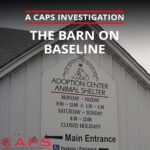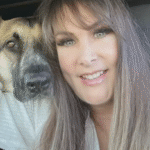Breeder: Lansdown, Tammy and Terry
Business name: Lansdown Kennel
Address: 1039 Morningside Rd
City, State Zip: Seymour, MO 65746
Year: 2015
USDA License: 43-A-1268
Date of CAPS Investigation: 03/17/15
CAPS Investigation: 03/17/15
Breeds: Boston Terriers, Beagles, Australian Shepherds, West Highland Terriers, Maltese, Yorkshire Terriers, Poodles, Dachshunds, French Bulldogs, English Bulldogs, Chihuahuas, Schnauzers, Shih Tzus, Orepeis, Pugs
Approximate number of dogs observed at the time of investigation: 160 dogs, 20 puppies
Lansdown Kennel consisted of five structures:
- an indoor breeder building with pens on the ground
- a Sundowner building with elevated indoor/outdoor cages stacked above each other
- an area of outdoor large dog runs
- a small building with two indoor/outdoor runs attached to one side
- a puppy/supply building
Indoor small dog building
The indoor small dog breeder building had a wooden frame with a metal roof over a dirt flooring, two metal walls with a sliding door to access one side, and plastic tarps laid partially covering the other two sides of the building. Four rows of about ten pens each were inside; each pen had thick galvanized wire walls with plastic self-feeders attached to them, plastic and metal water dishes on the floorings, and plastic dog houses inside; the outer rows of pens had plastic igloo-style dog houses, while the inner rows had plastic barrels that served as dog houses.. A thin layer of wooden chips was scattered across the floorings. Each pen held two to three dogs of various breeds.
A white French Bulldog, in a pen with a brown Dachshund, had swollen and red eyelids on its right eye, leaving that eye only about half as open as the dog’s left eye (Sec 2.40 Attending Veterinarian and Adequate Veterinary care (a) Adequate vet care). Two West Highland Terriers in one pen had small mats in their fur that were about three inches long (Sec 2.40 Attending Veterinarian and Adequate Veterinary Care (a) Adequate vet care). The dogs’ faces and bellies had small mats that were brown and appeared to be hard (Sec 3.6 Primary Enclosures (a) General requirements (2)(v) Enable dogs to remain dry and clean). One of the two Maltese in one pen had thick brown mats on its face, obscuring the dog’s eyes (Sec 2.40 Attending Veterinarian and Adequate Veterinary Care (a) Adequate vet care); (Sec 3.6 Primary Enclosures (a) General requirements (2)(v) Enable dogs to remain dry and clean).
Puppy building
The puppy building was an enclosed metal barn with six cages on one side; these cages each shared adjacent walls with the next cage. The cages were made of treated wire and had metal and ceramic food and water dishes inside. A hand towel was in each cage, as were dog toys. One occupied cage contained a metal self-feeder, much of which was covered with rust. One of these cages held a Boston Terrier puppy; one held two Boston Terrier puppies; another had two Shih Tzu puppies, and a fourth cage held two Chihuahua puppies. All of these puppies were less than eight weeks old. A brown and white Shih Tzu puppy, sharing a cage with a second Shih Tzu puppy, had green mucus discharge covering its nostrils (Sec 2.40 Attending Veterinarian and Adequate Veterinary Care (a) Adequate vet care). The Shih Tzu cage shared walls with other occupied cages, one housing the two Chihuahua puppies and one housing the single Boston Terrier puppy.
Heat lamps were above the cages, as were three cardboard boxes and a plastic folder. An empty cage contained a metal feeder, two plastic bowls, and a box of cereal, with two metal sheets stored on top of the cage (Sec 3.1 Housing facilities, general (b) Condition and site).
The wall opposite the cages had a water heater and shelves with tools, supplies, and medications stored on them in seemingly random order. A stuffed bear sat next to a microchip scanner, food bowls, and a small bag of feed on a blanket, while medications were set next to and on top off the water heater. A metal shelving unit had cleaning supplies on a metal shelf with holes in the shelf’s surface, positioned above various medications on the shelf below it. A lower shelf had a bottle of Pedia One with a hand-written “Pet Food” label on it, next to two plastic cups full of grooming supplies, a bottle of Pepto-Bismol, a roll of masking tape, a box of syringes, a box of Vanguard flea and tick treatment, and a Christmas ornament (Sec 3.1 Housing Facilities, General (b) Condition and site).
Sundowner kennel
The Sundowner kennel had a top and bottom row of eight indoor/outdoor cages on two sides of the facility. The construction of these cages was consistent with the others described: treated-wire walls, plastic sheeting to catch manure, plastic self-feeders, and water lines connected to nipples in the indoor cages. This barn was used primarily for whelping. An Orepei and two Boston Terriers had less than 12” of space from the tops of their heads to the tops of their cages when they stood normally.
Small structure for two dogs
Another structure consisted of a small metal building with two indoor/outdoor pens, each with a metal dog door allowing indoor/outdoor access. The outdoor pens had chain link walls and dirt floorings, and I observed a Labrador puppy and an Australian Shepherd in one pen.
Outdoor pens
There was a total of about ten outdoor pens, separated into two rows; these pens had chain link walls with dirt floorings, tarps partially covering the tops for shade, plastic igloo-style dog houses, metal self-feeders, and plastic water dishes. Each pen housed two to three dogs of breeds such as Cocker Spaniels, Cavalier King Charles Spaniels, and Australian Shepherds. A couple of these pens, made from galvanized wire walls, had plastic barrels that served as dog houses.
Statements made by Terry Lansdown regarding USDA and contradicting pet store claims:
As Terry Lansdown (Caucasian male, about 60 years old, 6’0”, 240 lbs., with short grey hair and glasses) showed me the facility, I spoke with him about the dog breeding business he and his wife operated. At one point I said to him, “The pet store wanted to come out, and they wanted to have someone meet with us. And that just sounds like a bunch of busy-ness. Do you have to mess with that?” He responded, “No. Inspectors. USDA. Missouri. That’s the only thing.” He added that if he can fix a problem at the kennel while a USDA inspector is present, he is not written up for it.
Mr. Lansdown said that a shipper sends the kennel’s puppies to Mount Vernon, Missouri, from where they are shipped to pet stores. The fact that Lansdown’s facility is located in Missouri contradicts the claim by Bow Wow Babies (Huntington, NY) that they use only local breeders whom they visit to “check out.”




